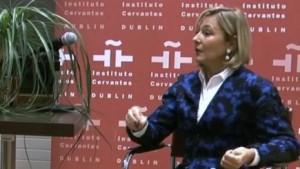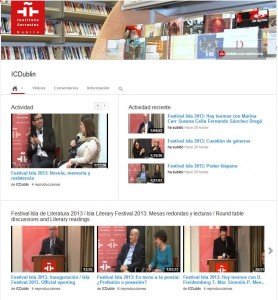Blog del Instituto Cervantes de Dublín
Torre Martello
Interview with Alicia Mariño
Alicia Mariño: Dracula is Comprised of the Best Elements of Both Gothic and Fantasy Literature
Interview with Alicia Mariño on 28th November 2012 at the Dámaso Alonso Library of the Instituto Cervantes in Dublin in connection with her participation in the discussion “The Fantastic: Hommage to Bram Stoker” with Luis Alberto de Cuenca and Jarlath Killeen.
Alicia Mariño holds a Ph.D. in French Language and Literature as well as a Law degree. Her doctoral thesis was on the role and significance of Fantastic literature in Villiers de l’Isle-Adam. She has since researched the Fantastic genre in the work of different authors. The results have been published as articles in various specialist journals and a book, published by Cátedra in the “Clásicos Universales” series, on Romance of a Mummy, by Théophile Gautier. Recently, her work has focused on comparative literature, studying the genesis and evolution of some European legends. She has also completed research in the field of women’s literature.
Alfonso Fernández Cid: —Alicia, what was your impression of Dracula after reading it for the first time?
Alicia Mariño: —It made a great impression on me. Not because it was scary but because I was fascinated by it. I think it’s one of those things where fantasy and gothic literature are mixed together. It’s a way of unconsciously banishing the fears we have as children, most of which follow us to adulthood. As Freud described it, the Das Unheimliche, or “uncomfortable strangeness”, is something that has accompanied us from the beginning of time and is ready to reignite fear or vertigo in those who seek it out, at any moment, triggered by any stimulus.
Alfonso Fernández Cid: —My next question follows on from this. How can we classify this novel? Is it a fantasy or gothic novel?
Alicia Mariño: —That’s a good question because it was published in 1897, and towards the end of the 19th Century, fantasy literature, in its strictest sense, was already quite popular. This style of literature, which was introduced in the first half of the Century during the Hoffman period, was perfected by Edgar Allan Poe in his search for verisimilitude and realism, and had already begun to influence the work of the French and new English writers.
Gothic literature, which began to develop towards the end of the 18th and beginning of the 19th Centuries (we know this from Walpole’s The Castle of Otranto) fascinated people, who perhaps became tired of castles, of the full moon, of ghosts and phantoms… and started to lose interest. Nevertheless, masterpieces continued to be written. What happened with Dracula? It was probably the culmination of the two genres, as it contains important elements of gothic literature, as well as the most important elements of fantasy, in the strictest sense, like the quest for verisimilitude.
The book is primarily written in diary form. This not only helps to develop realist writing, the basis for fantasy literature, but also the verisimilitude of the reader. The reader starts to believe, and above all, starts wondering if it’s true or not, if what is happening is possible or not, and it sparks a type of oppression, even fear. Also, because of certain events between the characters in the novel, there are moments when they ignore the truth because they can’t believe it. At the same time, there is “scientific” evidence of what is happening that’s going to make them believe it’s possible. It’s a game on two levels, in both thematic and formal aspects, between what is possible and impossible – the basis of fantasy literature.
Alfonso Fernández Cid: —Perhaps this is what makes this book so fascinating?
Alicia Mariño: —Definitely. It’s a masterpiece precisely because of this, as it contains the best elements from gothic literature, as well as elements refined by the new fantasy genre. It also deals with the mythical theme of vampires.
The vampire has been around since antiquity, in the form of Lilith, the first woman, the evil woman. Some say that she came before Eve and that she sucked the blood of little children.
A vampire is all about life, about blood, because blood gives life, and also about eternal life, the after-life. These stories or beliefs are passed down from generation to generation. Perhaps there’s a kernel of truth in the legends but eventually the stories are misinterpreted through repetition. There were diseases that created the living dead. They were buried alive because it looked like they were dead. A lot of things can strike fear into the human heart, like plagues in Europe, scurvy… illnesses that cause an illusion of death, for the heart to stop without being brain dead, something that doesn’t look like mortal death. Also, on the subject of vampires, there is an underlying link with the after-life, that one comes back or one is able to come back. “Who is with us?” “What creates the bridge between here and the afterlife?” This subject matter arouses fear of the unknown that constantly haunts us.
Alfonso Fernández Cid: —Where does this work stand today, in the reality that we live in? In the world of cinematography, there has been a certain evolution in the characters. Does it seem to have been transformed into something less romantic?
Alicia Mariño: —Yes, it’s more pedestrian. It doesn’t promote fear anymore. The myths have evolved and are continuously reinterpreted, that’s why they’re called myths. Ever since Anne Rice, vampires almost became a part of society or city life. After that, we saw the films that followed… now vampires have evolved with the times, they’re a little weak. I’m a bit surprised by this – there are vegetarian vampires, young people that fall in love and then turn their girlfriends into vampires. I think this succeeds in capturing the imagination of the next generation, as well as new readers. It fits in with the world of young people and that’s good. But undoubtedly, there’s a disconnect between generations.
Alfonso Fernández Cid: —Very few works have the same impact after 40, 70, 100 years.
Alicia Mariño: —That’s why Dracula is such a masterpiece, although I don’t think it’s been given enough weight. Perhaps because people don’t like fantasy literature or think it’s marginal. But I would put Dracula up there with the best works in world literature. Not particularly as genre literature, but for its perfection in terms of format, composition and theme. Besides, the most important aspect, as I said before, is the myth. The myth of death, the myth of the after-life and the myth of life. The myth forms part of our sub-conscious.
Man’s fear can be split in two. One side is the fear of disappearing physically, the fear of death. The other is the fear of losing our own identity, the fear of madness. These are the two greatest sources of fear. Nowadays, the vampire myth specifically touches on the theme of physical death. Meanwhile, man will be man and harbour feelings of immortality, although he is the only living thing that knows he is going to die. These kind of ideas are interesting but also disturbing, and above all, they help exorcise fear.
Recommended links
- [Video] Interview with Alicia Mariño at the Instituto Cervantes in Dublin, by Alfonso Fernández Cid.
- [PDF] “Entre lo posible y lo imposible: El relato Fantástico”. Essay by Alicia Mariño.
- [Video] “Ubicación del género fantástico”. Lecture by Alicia Mariño at the UIMP.




